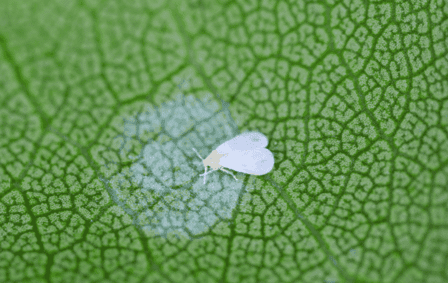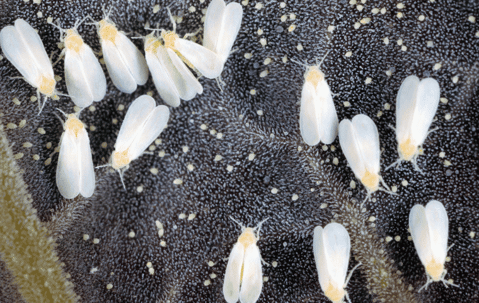Do I Need Professional Whitefly Control in Plantation, FL?
Many residents in Florida take pride in their lawns and for good reasons. With tropical weather most of the year, there are so many ways to customize and beautify your yard into an incredible oasis.
But are you noticing any of your plants’ leaves turning yellow and dropping off? While this could be from other plant diseases, it’s likely caused by whiteflies.
Whiteflies are teeny tiny white bugs that love to feed off of the plants in your landscape. This can cause plant stress and defoliation—turning your beautiful landscaping into a plant graveyard.
It can be hard to know how to get rid of whiteflies in Plantation, especially if you find an infestation in your yard. So, how do you prevent whitefly infestation?
Can you rely on home remedies or do you need professional whitefly control?
Read on to discover the best ways to control whiteflies!
What Are Whiteflies?
The name “whitefly” can be misleading because these insects are not true flies—instead, they are related to other garden pests like aphids, scales, and mealybugs. Their appearance doesn’t resemble flies either, as they look more like tiny white moths.
To feed, whiteflies suck the juices from the leaves of plants. They can do this because they have needle-like mouthparts that can pierce through the leaves and suck the sap.
Some of their favorite types of plants to feed on are ornamental plants, shrubs, and trees. Typically, whiteflies infest palm trees and ficus hedges. So, Florida has the prime landscaping for whiteflies to feast.
Whiteflies are rapid producers– each time they fly to a new plant, they can lay up to 400 eggs under leaves. They only reproduce when it’s warm enough, meaning you’ll find them where they can be active all year. This makes Plantation, and all over Florida in general, the perfect place for white flies.
After they hatch from their eggs, nymph whiteflies will look like small, white ovals. They will immediately begin feeding on plant juices from the leaves. This stage of whiteflies will cause the most damage in your yard.
Types of Whiteflies in Plantation
- The greenhouse whitefly
- The banded winged whitefly
- The giant whitefly
- The ficus whitefly
- The rugose spiraling whitefly
- The Silverleaf whitefly
The most common type of whitefly in Plantation is the Silverleaf whitefly. Their bodies are more of a yellowish color rather than a true white.
However, the rugose spiraling whitefly and the ficus whitefly are beginning to invade South Florida as well, so watch out for their egg spirals on the underside of plant leaves, especially on palm fronds and ficus hedge and ficus tree leaves.

Damages From Whiteflies
Whiteflies' feeding habits can cause extensive damage to your plants and trees.
When your plants and trees have large numbers of whiteflies on them, the host plant’s leaves will turn yellow, dry out, and eventually fall off the plant. The plant may be able to grow more leaves, but the whiteflies will come back to feed on the new growth. Or, if that plant is not well-established, it may die after whiteflies have fed on its leaves.
When a whitefly sucks on a plant leaf, if the plant has any diseases, the whitefly can “catch” the diseases. When the whitefly sucks on its next plant, it can transmit these viruses to that plant from the other host plants it has fed off of.
This can leave lasting effects on your plants—even after the whiteflies left—because the plant will then suffer from a virus the whiteflies deposited.
The whiteflies also produce honeydew, which is a sweet sticky substance that grows a fungus called sooty mold. As the sooty mold grows, it turns the leaves black and dirty so they can’t absorb the sunlight the plant needs for photosynthesis.
This causes more stress on the already damaged plant. The honeydew also attracts other insects, like ants. They love to eat the honeydew from whiteflies, and since it’s so low in protein, they need a lot of it to feel satisfied.
This means your home could have an ant infestation along with a whitefly infestation, making whiteflies an even bigger nuisance.
Honeydew can also cause damage to anything underneath infested trees, including pools, driveways, patios, furniture, and vehicles. It will fall off of the plants and onto these items, coating them with a sticky substance—which is difficult to remove.
Preventing Whitefly Infestations
With the damage that whiteflies can cause, it is important to proactively prevent whiteflies from invading your landscape.
Steps that will prevent whitefly infestations:
#1: Use Reflective Mulch
Early in the season, try using aluminum reflective mulch. This makes it difficult for the whiteflies to find their host plants. And if they can’t find them, they won’t feed and populate your landscaping.
#2: Put up yellow paper covered in petroleum jelly
Whiteflies are attracted to the color yellow, so they’ll fly to yellow paper. Then, they’ll get stuck in the petroleum jelly on the paper.
You can attach these yellow papers to sticks and place them around your garden and landscaping. This will help catch the whiteflies early, so they aren’t able to feed and reproduce.
#3: Irrigate your landscaping
With a lack of water, your plants will become stressed and at a higher risk to whiteflies. So, be sure that you’re watering your plants regularly, especially during dry seasons. This will keep them resilient.
#4: Use sunlight to your advantage
Sunlight can make plants stronger, which can help them defend themselves against whiteflies. Research the kind of sunlight your plants, trees, and shrubs prefer so you can put them in the right spot.
#5: Plant whitefly repelling plants
Planting catnip and marigolds around your plants can repel whiteflies. Other options are herbs like basil, chives, and dill.
Even with these preventative measures, you still may end up with a whitefly infestation. But how do you know? A few signs could indicate a whitefly infestation in your landscaping.
Signs of a Whitefly Infestation
- You see whiteflies on the underside of plant leaves.
- Finding tiny, white eggs in a circular pattern on the underside of plant leaves.
- Spotting the small white, tube-like Insects (which are the whitefly nymphs) on the underside of plant leaves.
- Your ornamental trees’ and plants’ leaves are turning yellow, drying out, or falling off.
- Your plants’ leaves are coated in a dirty black, moldy-type substance.
- A sticky black substance (sooty mold) covers your pools, pool decks, patios, furniture, cars, or anything sitting outside under trees.
- A cloud of whiteflies comes out of your plants when disturbed.
- If you see ants in or around your house, they may have been attracted due to honeydew from whiteflies on the plants and trees outside.
If you see any of these signs, there’s a high chance you have a whitefly infestation and it would be a good idea to take action. If delayed long enough, the whiteflies could continue damaging your plants.
Removing Whiteflies Plants
Whiteflies are difficult to remove on your own. They are notoriously resilient, they reproduce rapidly, they live in large populations, and they are active year-round in temperate weather regions like Florida. However, there are a few things you can try to control the whitefly population yourself.
When you catch whitefly infestations early, you can sometimes control them by washing them off the plants with water, essential oils, or insecticide soap.
You can fill a spray bottle with the product you choose to use to wash off the whiteflies and not harm the plant. Be sure to spray the underside of leaves because that is where the whiteflies’ larvae and eggs will be.
You’ll most likely need to spray the plants for several days until you do not find more whiteflies on the leaves.
You could consider purchasing some natural predators of whiteflies from your local nursery. Natural predators include lacewings, parasitic wasps, or ladybugs, and they will eat whiteflies.
When trying to control a whitefly infestation, you should remember to control the ant population because the ants can repel these beneficial insects.
You can set out ant bait or use non-repellant sprays for small affected areas with ants. Or, if the plant is larger, you can paint tree wrap with tanglefoot and wrap it around the plant's trunk. The tanglefoot is very sticky and should help trap the ants.
Do I Need Professional Whitefly Control?
While it’s possible to remove whiteflies on your own, everyone has busy lives. We totally understand that not everyone has the time or desire to get rid of a whitefly infestation.
Once your whitefly infestation has grown big enough, you won’t be able to remove them on your own. So, if you have large clouds of whiteflies coming off of several bushes or plants, you might want to call a professional pest control company to lean on.
And sometimes, even smaller populations are hard to eliminate. If you’ve tried some of the home remedies with no success, it is time to call for professional whitefly control.
Whitefly Control Near Me
Native Pest Management exists to help you out with all your pest needs, including whitefly treatments. We understand it can be hard to see the beautiful lawn you worked for start to deteriorate, and we want to give back the peace of mind that your lawn is taken care of.
So if you’re looking for whitefly services in Plantation, look no further! Our 5-star rating can tell you that we care about our customers and are ready to help.
We provide our professional whitefly services not just in Plantation, but also in the following counties:
- Miami Dade
- Broward
- Palm Beach
- Martin
- St. Lucie
- Indian River
Our whitefly treatment includes systemic insecticides which will be applied as a foliar spray and to the roots of affected plants. This quarterly service is designed to provide long-lasting protection from whiteflies.
Here at Native Pest Management, our whitefly control and prevention programs are guaranteed, so we can perform any additional treatment needed in between regular services with no additional charge.
Professional Whitefly Control in Plantation
Our process for whitefly prevention and treatment starts when we inspect your plants. We’ll identify bushes and trees that may be susceptible to damage by whiteflies or ones that are already infested.
After we identify the whiteflies and their host plants, we’ll determine if any lawn care practices have made your property and landscaping more susceptible to that infestation. We’ll recommend corrections to those practices where possible.
This approach to managing whitefly infestations doesn’t just respond to the whitefly damage, but it also aims to improve the long-term health of your lawn and minimize its risk to future pest activity.
If you’re ready to eliminate your whitefly infestation, contact Native Pest Management today! We’re excited to work with you and provide our eco-friendly, pet friendly whitefly treatment.
Whether you're looking for pest control in West Palm Beach, Port St. Lucie, Fort Lauderdale, Miami, or any of the surrounding areas, we’re here to help. We also now provide pest control services in Tallahassee.
Unsure whether you’re in a service area? Call us or visit our service area page!
Call us and schedule a free inspection or learn more about how our whitefly control services can help you reclaim your lawn in Plantation, Florida!
